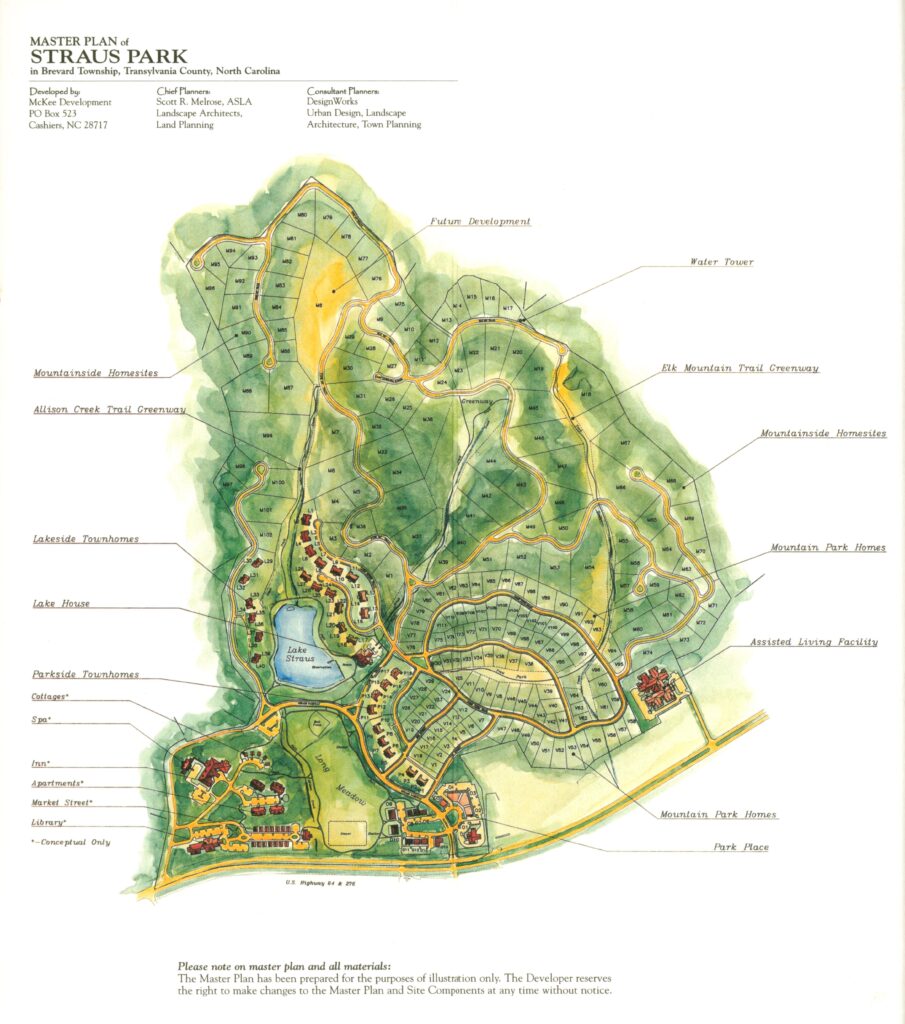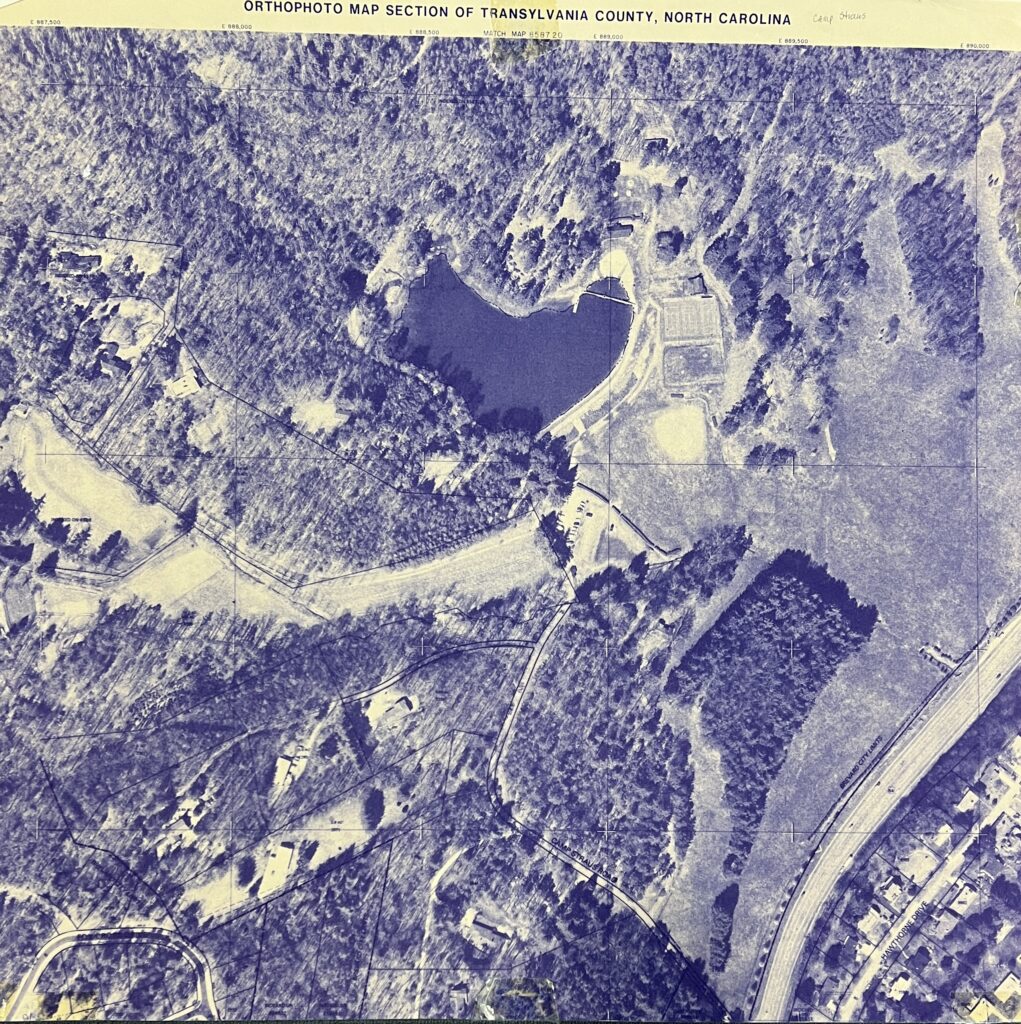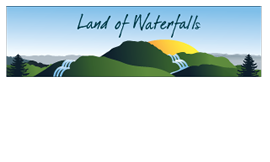
On June 23, 1997, developer William McKee purchased the 315-acre Harry H. Straus Park from P.H. Glatfelter, then-owner of the old Ecusta/Olin paper factory, for $4,000,000. In today’s money, McKee paid $7,626,976 for prime real estate that had served as a private recreational park for factory employees since 1945. Several groups sought to purchase the property in order to preserve the park for the community but could not meet the asking price.
McKee’s original plans called for building 240 homes, apartments, townhouses, a medical park, a retail area, a nursing home, and a 20-40 bed inn near Straus Lake. Mr. McKee even offered to donate a parcel of land to the county as a possible location for a new Transylvania County library. The nursing home, apartments, inn, and library never came to fruition. What did develop was a “neo-traditional community” – a new type of intentional development that includes housing as well as amenities like shops, restaurants and shared public spaces. The original park structures were demolished except for the lake and the current neighborhood of Straus Park took its place. Today most residents are unaware that the Straus Park development was once the location of a boy’s summer camp and then a large recreational park.
Camp Sapphire for Boys was founded in 1914 by “Captain” William McKinnon Fetzer, who coached football, basketball, and baseball at Davidson College, North Carolina State University and University of North Carolina — Chapel Hill between 1916 and 1925. Fetzer leased and eventually purchased the land from William Allison. The Camp Sapphire section of Allison’s large holdings was famous for the many deer and elk often found grazing in the fields and was known as Deer Park. A lake, built by Allison, was called Deer Park Lake.
In 1942 Harry Straus, the original owner of the Ecusta Paper Corporation, began using Camp Sapphire to hold his company’s 4th of July picnics. Straus purchased the property in 1945 from Captain Fetzer’s widow, Mrs. Dorothy Fetzer, and it became a full-time private recreational park for employees as well as a permanent location for the picnic. The land came with a large summer camp infrastructure already in place that included a lake for swimming and fishing, sleeping cabins, a lodge for reading and relaxing, a cafeteria with a kitchen, a medical building, an unheated gymnasium with a basketball court, tennis courts, a baseball field, trails, a shop building and more.

Straus hired a recreational consulting firm who made recommendations on ways to better utilize and improve the property. The lake was drained and dredged; the bottom of the swimming section of the lake was then covered with white sand. Trout were stocked in the lake to join the bass and bream already present. A new dock, diving boards and a lake-side boardwalk were also added. The original cafeteria was turned into a canteen with drinks and snacks. Additional playing fields were added along with a practice golf field, a playground, horseshoe pit, and a shuffleboard area. A large, covered picnic shelter was constructed along with barbeque pits.
The park retained the name Camp Sapphire until 1951, when Harry Straus passed away, and it was renamed Camp Harry H. Straus in his honor. The lake today is called Straus Lake. Camp Sapphire/Straus was continually in use. Employees could visit any time to take advantage of the amenities and could bring guests. Every Sunday was Family Day, which included special events such as movies in the gym and concerts by the Ecusta band. The factory’s numerous departmental and Industrial League teams played there. Pickup basketball games were always being held in the gym. And of course, the 4th of July picnic was a yearly event.
Summer programs were offered for employee’s children. One of the most popular was the Red Cross Aquatic School swimming and lifeguarding classes held at the lake, where many Transylvania County residents learned to swim. Another was a “coaching school” for boys, during which they were coached in baseball, participated in boxing for self-defense, and listened to daily talks on topics such as farming and safety. Girls were offered a choral and music program, and also studied the natural world and practiced arts and crafts. Another program was held for high school students who were members of the Ecusta Band. The young musicians would meet for practice three days a week throughout most of the summer. Of course, all these groups also had some “down time” to just have fun.
Although it was a private park, groups from the community were allowed to use Camp Straus for special events. Articles or notices in the Transylvania Times mention the Jaycees, Kiwanis, and Shriner annual picnics, family reunions, numerous church events, Boy and Girl Scout jamborees, and a Brevard College freshman picnic. There were also meetings held for groups such as the regional Volunteer Foreign Language Interpreters and the International Institute in Farm and Home Planning, the latter including representatives from eight countries. The Southern Archery tournament was even held there, with expert archers from 14 states participating.
Camp Sapphire/Harry H. Straus had a long history of use as a park for many organizations and citizens of Transylvania County; sadly, like the paper factory that was once part of its history, it is now but a fading piece of local lore. Photographs and information for this column are provided by the Rowell Bosse North Carolina Room, Transylvania County Library. This article was written by Local History Assistant Joe Russo. Sources available upon request. For more information, comments, or suggestions, contact NC Room staff at [email protected] or 828-884-1820.



